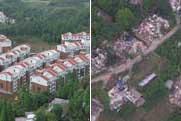China
Interview with expert from Chinese Academy of Sciences
WATCH VIDEO
Source: CCTV.com | 10-24-2007 13:39
Special Report: Chang'e I -Journey to the Moon |
The Chang'e One lunar project is a milestone in China's space exploration. But there are risks. CCTV International spoke to Ouyang Ziyuan, an expert from the Chinese Academy of Sciences.
Question: The Chang E Project is the third landmark event following the man-made earth satellite and manned space flight. What significance does it have to China's space exploration ?
Ouyang Ziyuan: Our country's lunar project has three phases: exploring, flying manned spacecraft, and settling on the moon. The first phase of exploration includes three steps for the satellite: orbiting, landing, and successfully returning to Earth. So we're in the first step of the first phase. It's the beginning of our country's lunar travel and paves the way for future journeys. We've never done this before, so we're establishing our own system and building our own teams. This is a new era of our nation's space exploration.
Question: Do you think there is the possibility of human exploration and utilization of lunar resources?
Ouyang Ziyuan: There are rich lunar resources like minerals and solar energy. Take helium-3 in the moon soil for example: it's the raw material for generating electricity through controllable nuclear fusion. China is studying this and maybe it can be used in commercial industry in 30 to 50 years. There could be a huge demand for an element that's in rich supply on the moon. So we must find out how much there is and where it can be found. Right now we are laying the foundation for further exploration. And the special environment of the moon is suitable for many cutting-edge experiments. Human exploration of the moon could be vital in sustaining Earth's development. It's likely humans will someday utilize the moon's resources.
Question: Aerospace is a high-risk field. And it is the first time China has launched a lunar satellite. What are the risks in this mission?
Ouyang Ziyuan: We have high potential risks because it's our first mission. And it's the longest distance we will cover in space: up to 380,000 kilometers. The satellites and manned spacecraft we have launched have only reached 36,000 kilometers on their longest journeys. The risks are in several areas: the first is the orbit. The satellite will travel for about 10 days. The problem is, how can we make the orbiter move in the designated path? It could stray from our plan and crash into the moon if we can't put a brake on it in time. The natural environment in space is extremely harsh. Another risk is, how can we keep the orbiter simultaneously positioned towards three moving objects: the earth and the moon and the sun? It's a serious challenge to control the satellite and measure relevant data. Those are the risks we face.
Editor:Zhang Ning



